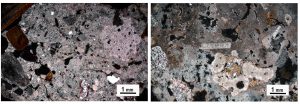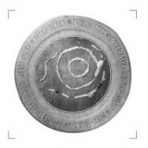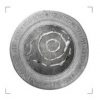In the frame of collaboration between the Department of Historical Science and Cultural Heritage and the Department of Physical, Earth and Environmental Sciences (R.U. Cultural Heritage Conservation) of the University of Siena , many samples of mortars collected from the archaeological site of Vetricella (Scarlino) and Carlappiano (Piombino) were analised. The aim of the investigation was to gather useful information for the identification of building techniques and the relative chronology of the various units of the site of Vetricella.
The mineralogical-petrographic analyses carried out thus far pointed out that all the mortars object of investigation have very similar composition (Fig.1). They are composed only by lime with variable quantities of under burnt relics of the original stone used for the production of lime, sometimes containing just few quantities of non-carbonate materials probably representing accidental components rather than a deliberate addition (lime/aggregate ratio tipically around 3/1 or 2/1). This non-carbonate aggregate is mainly composed by siliciclastic fragments (argillites and siltites) and siliceous lithoclasts (cherts).
The presence of abundant under burnt relics allowed to characterize the original stone used for the production of lime as travertine or calcareous tufa. The high variability of microstructures of these lithotypesdid not allow to distinguish the mortars on the basis of the analysis of the binder.
Given the geographic location in which the Vetricella site is located, it can be assumed that the materials used for the production of the lime binder come from deposits of calcareous tufa widely cropping out in the area of Massa Marittima.
At present there are still some questions to be clarified from the technological point of view, both in relation to the significant presence of under burnt relics of the original lime stone (whether they are intentional or not), and to the small quantities of siliciclastic materials (not clear whether they are due to “earthy” impurities already present in the original lime stone or incorporated by the lime in the slaking pit). The continuous comparison of the results of the petrographic analysis with the archaeological investigations will surely give these and other answers to the present study.
In this photo: lumps of microcrystalline calcite and abundant under burnt relics of the original lime stone are spread in the lime binder.



